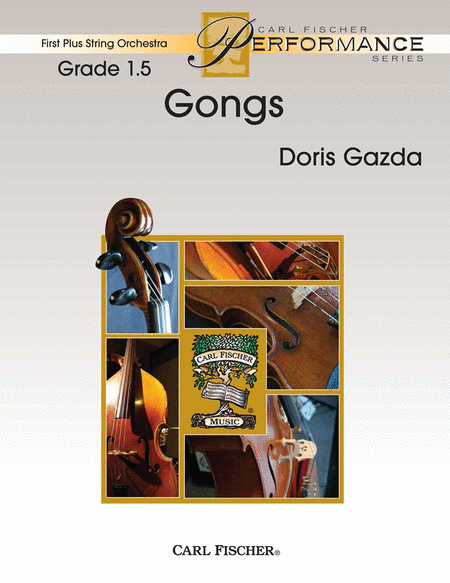Gongs
-
Ships in 1 to 2 weeks
Details
Description
SKU: CF.FAS51
Composed by Doris Gazda. Arranged by Doris Gazda. FS - SWS. First-Plus String Orchestra (FAS). Set of parts. With Standard notation. 5+2+8+5+8+5+2+8 pages. Carl Fischer Music #FAS51. Published by Carl Fischer Music (CF.FAS51).ISBN 9780825869303. UPC: 798408069308. 8.5 X 11 inches. Key: A minor.
Written to depict the sound of Chinese gongs, this Eastern-influenced piece by renowned composer Doris Gazda may be her best work to date. Gongs features unique harmonic colors and interesting textures that are exciting for players and audiences alike.
A gong is a musical instrument that is in the shape of a flat disc. It is usually made of bronze or brass. Gongs are commonly found in East and South East Asia. A suspended gong is hung on a stand by a cord that passes through holes at the top rim. Large gongs are struck with a padded mallet, but they may also be struck with wooden or metal sticks and can even be played with the bow of a string bass.The Chinese used large gongs to head processions, and the gongs were struck to announce the arrival of very important people. Small gongs were used in Chinese opera to announce the entrance of players and to point out parts of the opera that were funny. The people of Indonesia use sets of tuned gongs in their Gamelan musical ensembles. Gamelan ensembles also have xylophones, drums, bamboo flutes and string instruments.Cymbals are gongs that are raised a little in the middle. Cymbals can be very large or tiny enough to be played by two fingers. Two cymbals are used to make crashing sounds, whereas one cymbal that is suspended is struck with mallets or sticks. Gongs and cymbals are used by composers in orchestral and band music. They add tone color and variety to the music.The sound of a gong being struck is of an accented sound with a long residual tone that seems to die away. This effect is called “decay.” Try to produce the gong sound by pressing your bow into the string at the beginning of the note and then drawing the bow lightly across the strings as the tone keeps sounding. All of the tones should be played legato, which means smooth and connected.

 Share
Share